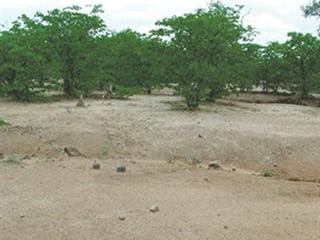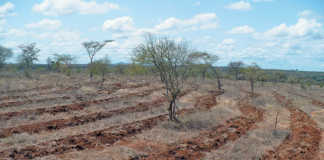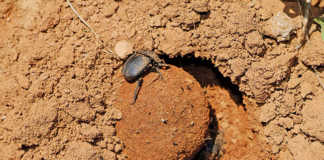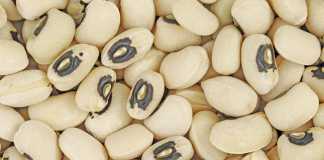
Sheet erosion and donga formation are the two most serious forms of erosion. Both types require intervention through a rehabilitation management plan and follow-up maintenance. A hallmark of sheet erosion is large bare patches of veld with a hard surface and low amounts of organic material, making plant growth virtually impossible. A donga forms when flowing water cuts a channel into the soil. Where ground falls away, a donga head forms that gradually works its way upstream, widening and deepening the donga.
Sheet erosion
Frits van Oudtshoorn of the Modimolle-based Africa Land Use Services explains that the aim of sheet erosion restoration is to establish vegetation that protects the soil and then allows natural regeneration processes to take over. Before rehabilitation begins, the cause of sheet erosion at a site needs to be understood and dealt with. “If the cause was overgrazing, which is usually the case, the grazing system and/or stocking rate should be decreased to match the decreased grazing capacity,” explains Frits.

Vetiver grass (native to India)established along the contours is an effective method of slowing down water run-off.
Until vegetation is well established, the restoration site must be protected from grazers by fences, brush packing or by establishing selected unpalatable grass species. In combating sheet erosion, it is important to increase water infiltration and reduce water run-off. “Using a basin plough to break the hard crust on the soil surface aerates the ground and allows water to be easily absorbed. This promotes seed germination,” says Frits. “The basins created by the plough collect water, seed and organic material that would otherwise have been lost through wind or run-off water.”
Grazing the area with high cattle numbers for a short period can also break the hard crust. Their dung and urine provides nutrients and organic material which improves fertility and provides a suitable layer for the germination of seeds. To further retard run-off water and increase infiltration, pack stones, brushwood or logs on the contour. This traps sediment and seed and vegetation soon establishes itself.
Another method involves the construction of small dams in a mosaic pattern to collect run-off water. “Seed can be sown in the dams with fertiliser, manure or compost to aid plant growth. This method is usually used where there’s a slope.”
Donga erosion
“To combat donga formation, the speed of the water, that carries soil away, must be slowed,” says LD van Essen of the Centre for Wildlife Management at the University of Pretoria. “Objects placed in the water’s way will have this effect. Old tyres, rocks and rubble can be used.” If the donga is in an advanced stage, construct a weir at the head to prevent it from spreading further upstream. This acts like a wall, slows down water flow and traps soil behind it. The soil fills up the donga in time and vegetation soon establishes itself.
When building a weir, key the sides thoroughly into the un-eroded edges of the donga on either side. This will prevent water from eroding the sides and creating a path around the weir. “The weir must have a firm and deep foundation to prevent it from being washed away,” says LD. “A large apron in front of the wall ensures that overflowing water doesn’t gouge a cavity at the base of the wall, erode the area and weaken the foundation.”
Material used to build a wall can range from rocks or bricks and cement to packed stones incorporating shade cloth or geofabric, as long as it slows down the water and builds up soil and silt in which vegetation can establish. When using locally collected rock and stones, be careful not to start a new erosion problem where you remove them.
Sure-fire solution with brush packing
Packing brush on bare patches increases water infiltration, reduces the soil surface temperature, allows a seed bank to build up and adds organic material to the soil. This is a low-cost method where results can be seen in a relatively short time. “It should be used in combination with crust breaking and re-seeding, but where topsoil is not excessively degraded, it can be used on its own,” says Frits van Oudtshoorn of Africa Land Use Services.
Erosion and bare patches where nothing could grow was a big problem on André Cochrane’s farm near Vaalwater, Limpopo. “Our farm was completely transformed within a season after implementing brush packing. Where once nothing grew, the grass is now a metre high,” says André. A 50cm-thick layer of brush on the degraded soil protected it from the sun and rain, and allowed grass seed to accumulate, he explains.
“The wind blew seeds up against the brush and, because the soil was moist from the rain, grass soon started to grow. The branches protected the grass from grazers so it was well established before they could reach it. “Brush packing works and I can recommend it to anyone who has sheet erosion problems on the farm,” says André.
-5B1-5D.gif)
When building a weir, key the side walls well into the uneroded edges of the donga. A large apron in front of the wall protects the foundation from the eroding effect of overflowing water that would otherwise create a cavity and weaken the foundation. Photo by Frits van Oudtshoorn
Plant grass to stabilise soil and prevent run-off
Plants which provide cover are crucial in the fight against erosion, preventing soil from being washed away and improving water infiltration. Locally adapted indigenous grasses can increase the success of a rehabilitation project. Seed can be collected from any good grass stand when it is ripe. Grass species suitable for different veld types include red grass (Themeda triandra), finger grass (Digitaria eriantha), spear grass (Heteropogon contortus) and bloubuffelsgras (Cenchrus ciliaris).
Contact Africa Land Use Services on 014 717 3819, 086 531 6075 or [email protected], or visit www.alut.co.za
Contact the Centre for Wildlife Management at the University of Pretoria on 012 420 2627/2569.













